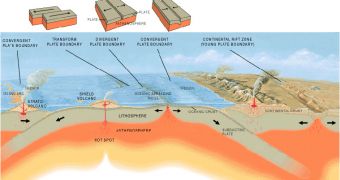Over the past few years, increasingly complex computer models have began painting interesting pictures of how the insides of our planet looks like, and that view is continuously getting better.
Though it may seem unmovable, the ground is in fact floating on an ocean of molten rock called magma. This layer of the planet envelops the core and is called the mantle.
There are several large tectonic plates drifting on the mantle, as well as a larger number of smaller plates, and all of them are in constant collision with each other.
Their motions on the magma ocean are driven by a variety of large-scale physical and chemical processes, such as for example convection currents.
Knowing how and why this happens is key for developing a better understanding of the way the crust behaves, which may in turn lead to more advanced earthquake-predicting capabilities,
Two of the main consequences of tectonic activity are volcanic eruptions and earthquakes. A third is that the surface of the planet is being constantly remodeled, at very low speeds.
In a few million years, the face of the Earth will look very different than it does now. The Pacific Ocean will be smaller, the Atlantic will be larger, and Africa will host a new sea.
But, in order to be able to predict how the Earth will evolve, we need to be able to understand the world beneath our feet better than ever before, OurAmazingPlanet reports.
In a paper appearing in the August 27 issue of the esteemed journal Science, researchers publish a list containing some of the possible discovery even more advanced computer models could help us make.
A new type of simulation algorithm was recently developed at the California Institute of Technology (Caltech), in Pasadena. It represents a departure from more traditional, high-resolution computer models.
“With this method, you don't need fine resolution everywhere. You can just zoom in on places you care more about, like plate boundaries where most of the deformation occurs,” explains University of Southern California expert Thorsten Becker, who was not a part of the research.
“If you were to look down upon our planet as an alien, you would see it boiling away over long periods of time as a big heat engine. This study tells us how the physics of that heat engine really works,” adds Caltech study team member Michael Gurnis.
He adds that understanding tectonic activity is of tremendous importance for science, given that they influence both the water and carbon cycles on Earth, which are indispensable for supporting complex life.

 14 DAY TRIAL //
14 DAY TRIAL //